14
2024
-
09
葉黃(huáng)素共晶--量小(xiǎo)利大(dà)
【概要(yào)描述】
葉黃(huáng)素(LT)及其同分(fēn)異構體(tǐ)玉米黃(huáng)質,屬于植物(wù)類胡蘿蔔素家(jiā)族成員(yuán)。葉黃(huá'ng)素是(shì)一(yī)種天然的(de)色素,其結構由兩端的(de)兩個(gè)環己烯環和(hé)中間(jiān)的(de)一(yī)長(€cháng)鏈多(duō)烯組成[1]。多(duō)烯鏈賦予葉黃(huáng)素分(fēn)子(zǐ)典型的(de)顔色屬性。鑒于其吸收藍(lán)光(guāng)的(de)能(néng)力,葉黃(huáng)素具有(yǒu)黃(hu✘áng)色或橙色的(de)外(wài)觀[2]。因此,它被廣泛用(yòng)作(zuò)飼料和(hé)食品添加劑的(de)著(zhe)色劑。
此外(wài),葉黃(huáng)素具有(yǒu)抗氧化(huà)作(zuò)用(yòng),能(néng)夠提高(gāo)動物(wù)↔的(de)生(shēng)産性能(néng)[3],尤其是(shì)在高(gāo)溫條件(jiàn)下(xià),葉黃(huáng)素對(duì)肉雞的(de)生(shēng)長(chán≥g)性能(néng)和(hé)著(zhe)色效果均有(yǒu)促進作(zuò)用(yòng)[4]。葉黃(huáng)素作(zuò)為(wèi)一(yī)種重要(yào)的(de)營養物(wù)質,因其獨特屬性而被廣泛應用(yòng),如(rú)作(zuò)為(wèi)強效抗化(h•uà)劑和(hé)高(gāo)能(néng)藍(lán)光(guāng)的(de)有(yǒu)效屏障,積聚在人(rén≤)眼晶狀體(tǐ)和(hé)視(shì)網膜中[5,6]。同時(shí)研究發現(xiàn),補充葉黃(huáng)素能(néng)夠改善心血管功能(néng)并保護皮膚等[7,8]。
然而葉黃(huáng)素的(de)不(bù)穩定性限制(zhì)了(le)其應用(yòng)[9,10]。葉黃(huáng)素的(de)共轭多(duō)烯鏈結構導緻其化(huà)學穩定性差,在光(guāngα)照(zhào)和(hé)高(gāo)溫下(xià)易發生(shēng)氧化(huà)裂解[10],這(zhè)使得(de)葉黃(huáng)素在儲存和(hé)加工(gōng)過程中非常困難。此外(wài),葉黃(huáng)素因溶解性低(dī)而導緻吸收性差,生(shēng)物(wù)利用 (yòng)度低(dī)[11-13]。
共晶科(kē)技(jì)應用(yòng)藥物(wù)共晶技(jì)術(shù)獲得(de)的(de)專利産品葉黃(huáng)素共晶:Cry÷sVital TM Lutein,穩定性增強(如(rú)圖1),溶解度提高(gāo)(如(rú)圖2),生(shēng)物(wù)利用(yòng)度增加(如(rú)圖3)。與市(§shì)售葉黃(huáng)素産品相(xiàng)比,CrysVital TM Lutein 在體(tǐ)內(nèi)的(de)最大(dà)血漿濃度提升了(le)約4倍(表1所示)[14]。CrysVital TM Lutein,拓寬了(le)葉黃(huáng)素産品的(de)應用(yòng)途徑。
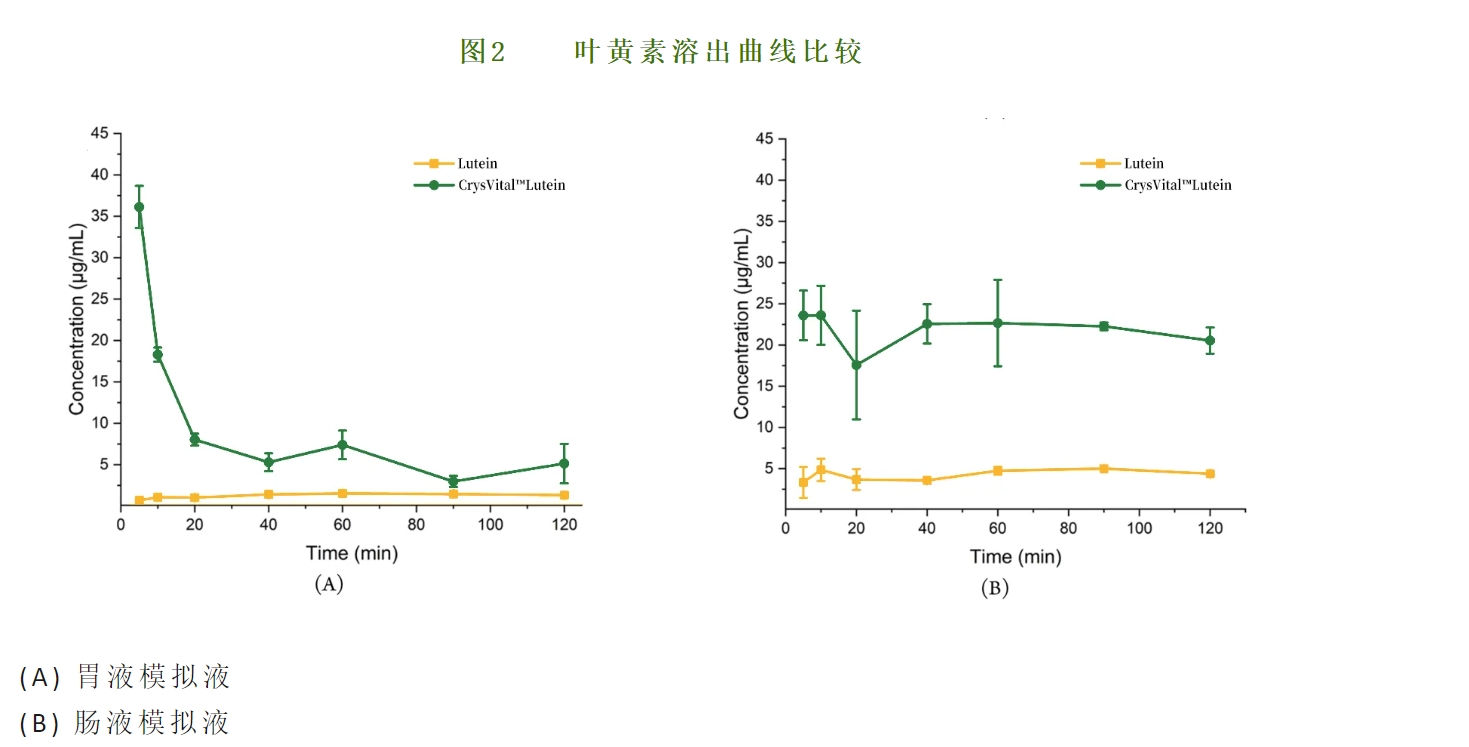
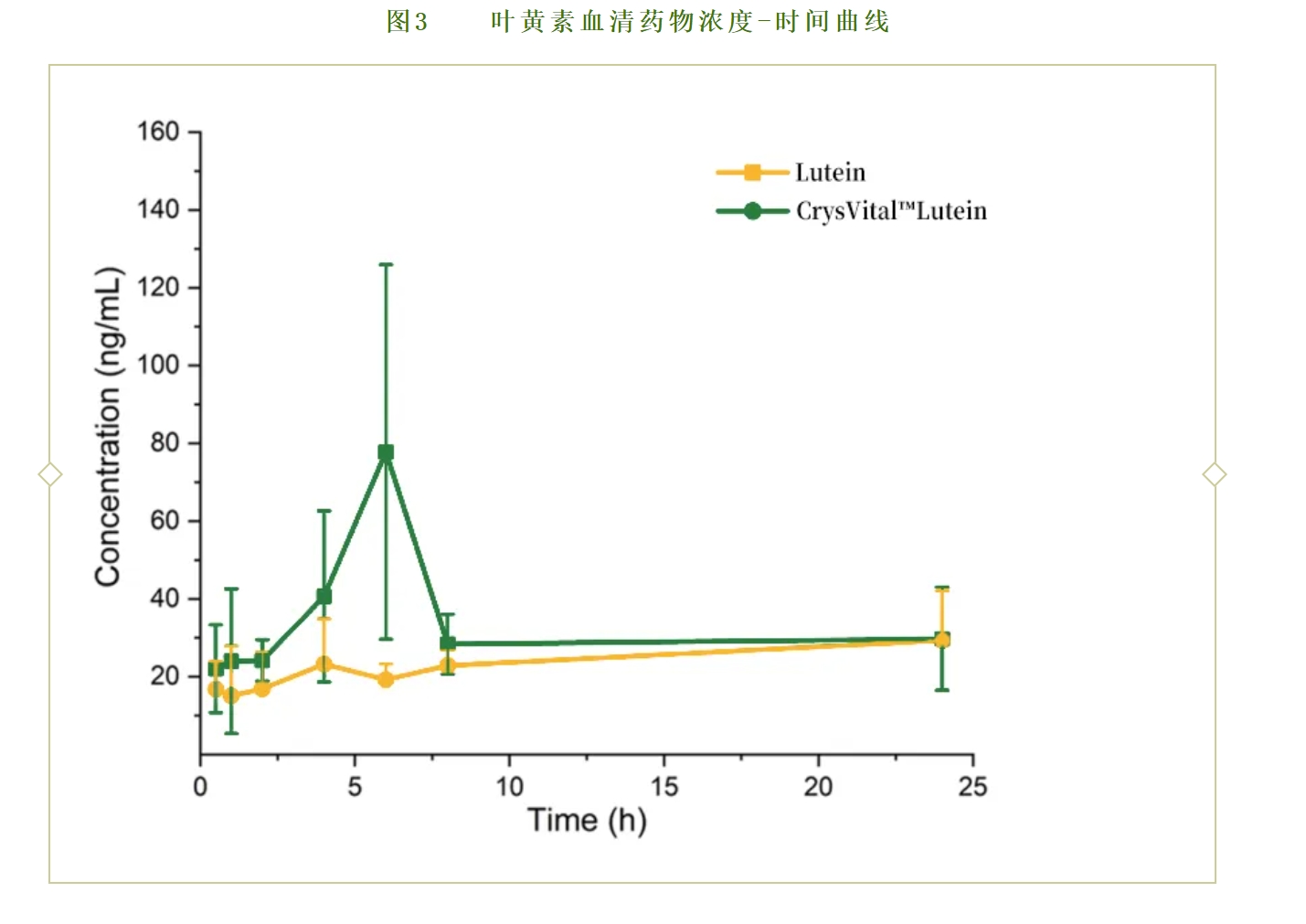
中國(guó)農(nóng)業(yè)科(kē)學院飼料研究所在研究日(rì)糧中添加CrysVital TM Lutein 對(duì)産蛋高(gāo)峰期蛋雞沉積效果的(de)影(yǐng)響時(shí)發現(xiàn):
(1)由圖4可(kě)知(zhī),與對(duì)照(zhào)組相(xiàng)比,日(rì)糧添加葉黃(h uáng)素能(néng)夠極顯著提高(gāo)雞蛋蛋黃(huáng)顔色(P < 0.01)。實驗21d時(shí),除CrysVital TM Lutein(5 mg/kg)組外(wài)其餘四組蛋黃(huáng)顔色顯著高(gāo)于對(duì)照(zhào)組(P < 0.05);實驗28d時(shíσ),CrysVital TM Lutein(20 mg/kg)組和(hé)市(shì)售産品C(20 mg/kg)組蛋黃(huáng)顔色顯著高(gāo)于對(d≈uì)照(zhào)組和(hé)CrysVital TM Lutein(5 mg/kg)組(P < 0.05),且CrysVital TM Lutein(20 mg/kg)組蛋黃(huáng)顔色最高(gāo)。
日(rì)糧添加同劑量葉黃(huáng)素,與L組相(xiàng)比,CrysVital TM Lutein(20 mg/kg)組蛋黃(huáng)顔色提升7.6%;與C組相(xiàng)比,CrysVital TM Lutein(20 mg/kg)組蛋黃(huáng)顔色提升12.2%。
日(rì)糧添加1/2劑量葉黃(huáng)素(CrysVital TM Lutein 産品10 ppm),與L組相(xiàng)比,CrysVital TM Lutein(10 mg/kg)組蛋黃(huáng)顔色提升4.5%;與C組相(xiàng)比,CrysVital TM Lutein(10 mg/kg)組蛋黃(huáng)顔色提升9.1%
與對(duì)照(zhào)組相(xiàng)比,日(rì)糧添加葉黃(huáng)素對(duì)雞蛋內(n<èi)葉黃(huáng)素含量有(yǒu)極顯著影(yǐng)響(P < 0.01)。CrysVital TM Lutein(20 mg/kg)組在實驗14d和(hé)21d時(shí)雞蛋內(nèi)葉黃(huáng)素含量顯←著高(gāo)于其他(tā)組,在實驗28d時(shí)CrysVital TM Lutein(10 mg/kg和(hé)20 mg/kg)組和(hé)市(shì)售産品C(20 mg/kg)組顯著高(gāo)于其他(tā)三組。
日(rì)糧添加同劑量葉黃(huáng)素,與L組相(xiàng)比,CrysVital TM Lutein(20 mg/kg)組蛋黃(huáng)葉黃(huáng)素含量提高(gāo)5.87 mg/kg(18.55 mg/$kg vs 12.68 mg/kg);與C組相(xiàng)比,CrysVital TM Lutein(20 mg/kg)組蛋黃(huáng)葉黃(huáng)素含量提高(gāo)4.55 mg/kg(1♣8.55 mg/kg vs 14.00 mg/kg)。
日(rì)糧添加1/2劑量葉黃(huáng)素(CrysVital TM Lutein 産品10 ppm),與L組相(xiàng)比,CrysVital TM Lutein(10 mg/kg)組蛋黃(huáng)葉黃(huáng)素含量提高(gāo)2.63 mg/kg(15.31 mg/kg vs☆ 12.68 mg/kg);與C組相(xiàng)比,CrysVital TM Lutein(10 mg/kg)組蛋黃(huáng)內(nèi)葉黃(huáng)素含量提高(gāo)1.31 mg/kg(≥15.31 mg/kg vs 14.00 mg/kg)。
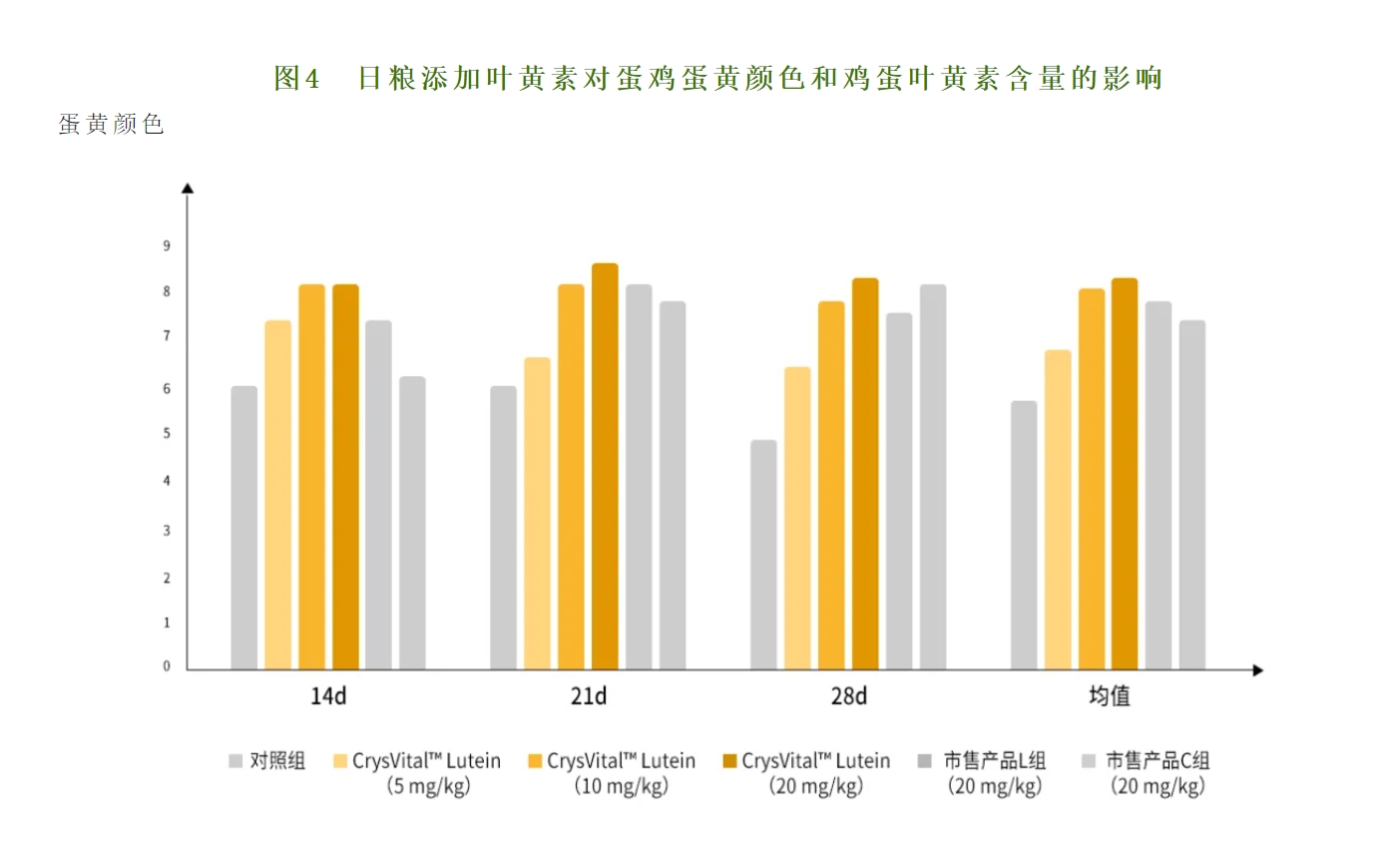
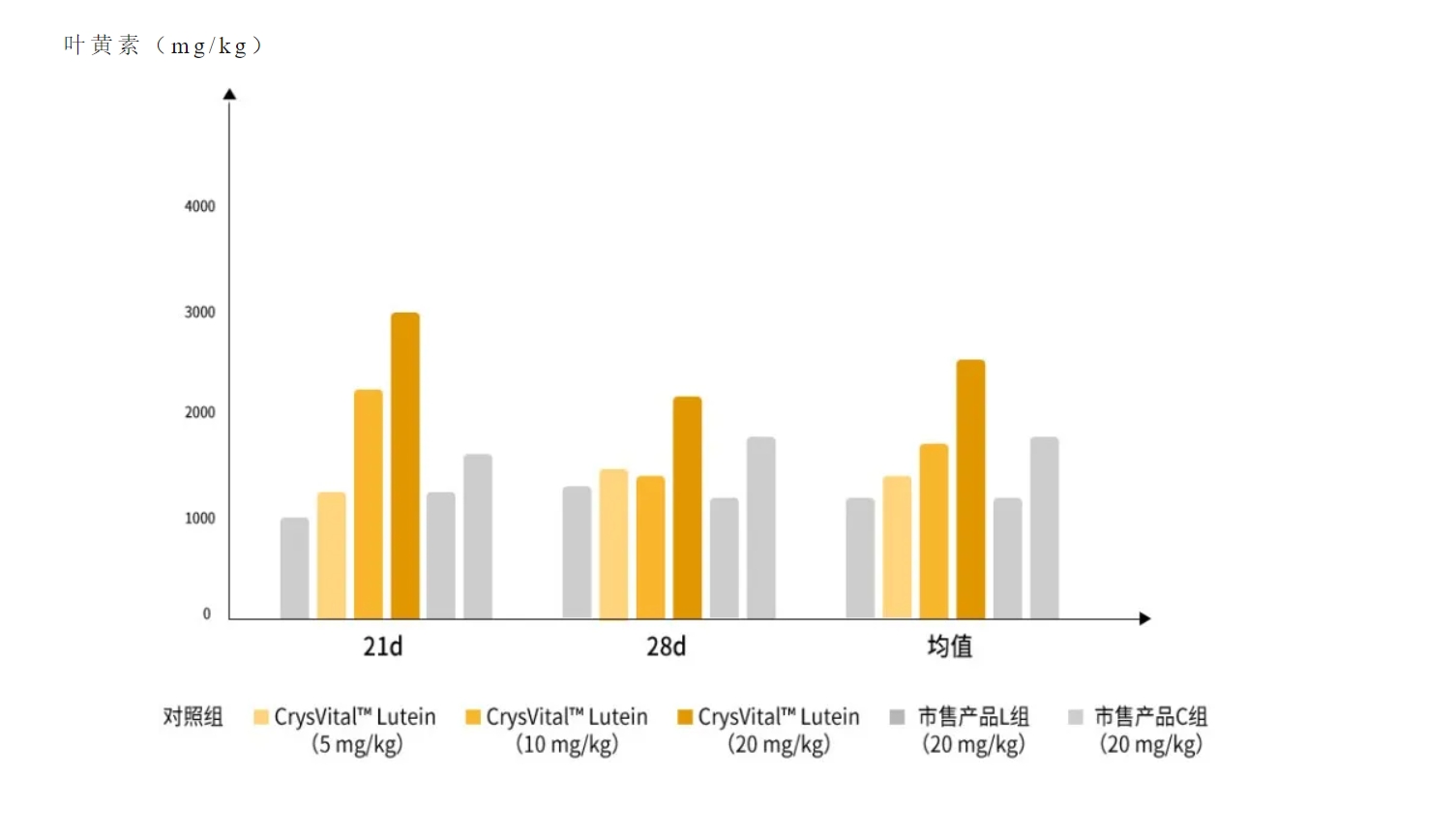
(2)由圖5可(kě)知(zhī),與對(duì)照(zhào)組相(xiàng)比,實驗21d時(shí),CrysVital TM Lutein(10 mg/kg和(hé)20mg/kg)組血液葉黃(huáng)素含量顯著高(gāo)于其他(tā)四組(P < 0.01)。
日(rì)糧添加同劑量葉黃(huáng)素,與L組和(hé)C組相(xiàng)比,CrysVital TM Lutein(20 mg/kg)組血液葉黃(huáng)素含量分(fēn)别提高(gāo)1252.9 ng/ml(2463.4 ng∑/ml vs 1210.5 ng/ml)和(hé)709.4 ng/ml(2463.4 ng/ml vs 1754.0 ngΩ/ml)。
日(rì)糧添加1/2劑量葉黃(huáng)素(CrysVital TM Lutein 産品10 ppm),與L組相(xiàng)比,CrysVital TM Lutein(10 mg/kg)組血液葉黃(huáng)素含量提高(gāo)464.2 ng/ml(1674.7 ng/ml vs 1210.5 ng/ml);與C組相(xiàng)比,CrysVital TM Lutein(10 mg/kg)組血液葉黃(huáng)素含量接近(jìn)(1674.7 ng/ml vs 1754.0 ng/ml)。
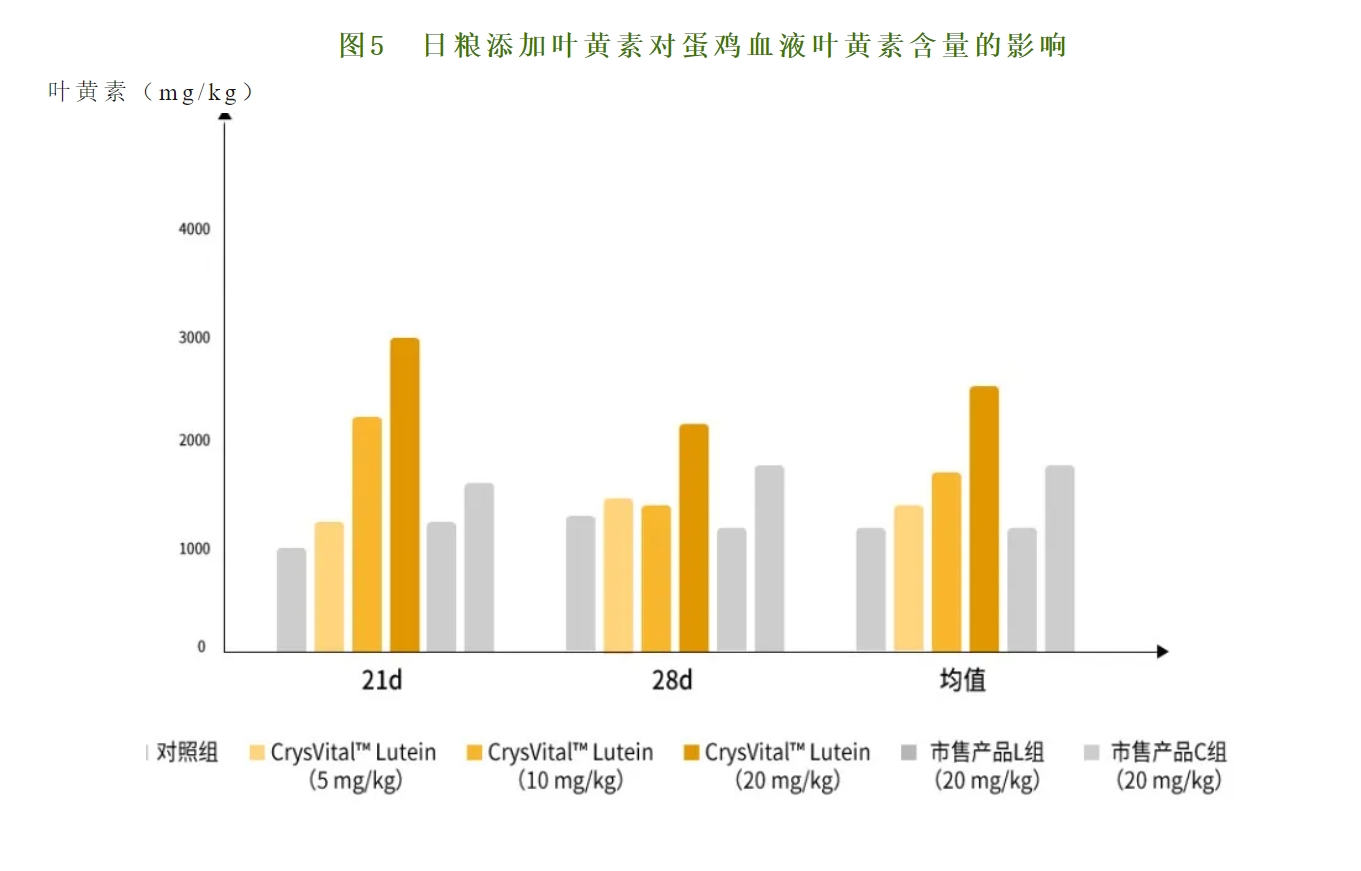
綜上(shàng)所述:(1)日(rì)糧添加葉黃(huáng)素能(néng)夠顯著改善雞蛋蛋黃(huáng)顔色,提高(gā£o)雞蛋及血液中葉黃(huáng)素含量。(2)與市(shì)售葉黃(huáng)素産品相(xiàng)比,日(rì)∑糧添加同劑量葉黃(huáng)素,CrysVital TM Lutein 對(duì)改善蛋黃(huáng)顔色、提升雞蛋及血液中葉黃(huáng)素含量具有(yǒu)明(míng)顯優勢。(←3)日(rì)糧添加CrysVital TM Lutein 10 mg/kg,即葉黃(huáng)素含量相(xiàng)當于1/2的(de)市(shì)售葉黃(huáng )素産品組,CrysVital TM Lutein 對(duì)蛋黃(huáng)顔色的(de)改善效果、雞蛋及血液葉黃(huáng)素含量與市(shì)售葉黃(huán€g)素産品組相(xiàng)當。
CrysVital TM Lutein 與市(shì)售葉黃(huáng)素産品相(xiàng)比,生(shēng)物(wù)活性物(wù)質葉黃(huáng)素的(de)溶解度和(hé)生(πshēng)物(wù)利用(yòng)度大(dà)幅提升,拓寬了(le)葉黃(huáng)素産品的(de)應用(yòng)途徑。藥物(wù✔)共晶技(jì)術(shù)的(de)研發不(bù)僅在于解決葉黃(huáng)素在實際應用(yòng)中的(de)難點,更重要(y←ào)的(de)是(shì)作(zuò)為(wèi)一(yī)種新的(de)産品聯用(yòng)方式,更大(dà§)程度地(dì)提升了(le)産品的(de)協同價值。
參考文(wén)獻:
[1] Kijlstra, A.; Tian, Y.; Kelly, E. R.; Berendscho¥t, T. Lutein: More than just a filter for blue light[J]. Prog Retin Eye Res. 2012✔, 31, 303−315.
[2] Roberts, J. E.; Dennison, J. The Photobiology of Lutein and Zeaxanthin in the Eyσet[J]. J. Ophthalmol. 2015, 2015, 1−8.
[3] Hayashi R, Hayashi S, Arai K, et al. The gender-differΩentiated antioxidant effects of a lutein-containing supplement in the aqueous humor of patients with senile cataracts[J]. Exp Eye Res, 2014, 129: 5-12
[4] Cota, F.; Costa, S.;Giannantonio, C.; Purcaro, V.; Catenazzi,β P.; Vento, G. Lutein supplementation and retinopathy of prematurity: a metαa-analysis[J]. J Matern Fetal Neonatal Med. 2022, 35, 175−180.
[5] 郭俊傑,季紹東(dōng),鄒世傑,等。不(bù)同類型葉黃(huáng)素對(duì)高(gāo)溫條件(jiàn)下(xià)黃(huáng)羽肉雞生(shēn g)長(cháng)性能(néng)及著(zhe)色效果的(de)影(yǐng)響[J]. 中國(guó)畜牧雜(zá)志(zhì), 202λ1, 57: 151-154.
[6] Tan, J. S. L.; Wang, J. J.; Flood, V.; Rochtchina, E.; Smith, W.; Mitchell, P. Dietary a✘ntioxidants and the long-term incidence of age-related macular degeneration - The Blu✘e Mountains Eye Study[J]. Ophthalmology. 2008, 115, 334−341.
[7] Grether-Beck, S.; Marini, A.; Jaenicke, T.; Stahl, W.; Krutmann, J. Molecular evidence t♣hat oral supplementation with lycopene or lutein protects humεan skin against ultraviolet radiation: results from a double-blinded, placebo-cont×rolled, crossover study[J]. Br J Dermatol. 2017, 176, 1231&m•inus;1240.
[8] Chen, Y. M.; Wang, L.; Huang, S. X., et al. Lutein attenuates an giotensin II- induced cardiac remodeling by inhibit→ing AP-1/IL-11 signaling[J]. Redox Biol. 2021, 44, 102₩020.
[9] Boon, C. S.; McClements, D. J.; Weiss, J., et al. Factors Influencing the Chemical Stabi∞lity of Carotenoids in Foods[J]. Crit Rev Food Sci.' 2010, 50, 515−532..
[10] Ochoa Becerra, M.; Mojica Contreras, L.; Hsieh Lo, M., et al. Lutein as a functional f★ood ingredient: Stability and bioavailability[J]. J Funct Foods. 20±20, 66, 103771.
[11] Arnal, E.; Miranda, M.; Johnsen-Soriano, S, et al. Beneficial Effect of Docosahexanoic Acid and Lutein on Retinal Structural, Metabolic, εand Functional Abnormalities in Diabetic Rats[J]. Curr Eye Res. 2009, 34, 928−938.
[12] Xu, D. X.; Aihemaiti, Z.; Cao, Y. P., et al. Physicochemical stability, microrheologiλcal properties and micro structure of lutein emulsions stabilized ₹by multilayer membranes consisting of whey protein isolate, f↑laxseed gum and chitosan[J]. Food Chem. 2016, 202, 156&m∏inus;164.
[13] Zhao, C. D.; Cheng, H.; Jiang, P. F., et al. Prepa≥ration of lutein-loaded particles for improving solubility and stability by Polyvinylpyrr¥olidone (PVP) as an emulsion-stabilizer[J]. Food Chem. 2014, 156, 123−128.α
[14] Zheng, C.; Wang, H.; Xiao, Z.; et al. Cocrystal of Lutein with Improved St¥ability and Bioavailability[J]. ACS Omega.2024, 34, 36389-36397.
上(shàng)一(yī)篇
下(xià)一(yī)篇
上(shàng)一(yī)篇
下(xià)一(yī)篇
相(xiàng)關推薦



